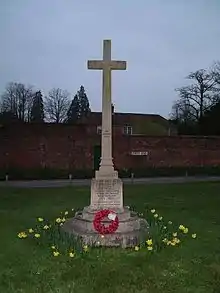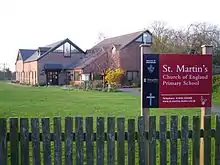East Woodhay
East Woodhay is a village and civil parish in Hampshire, England, situated approximately 6 miles (10 km) south-west of Newbury in Berkshire. As of the 2001 census, it had a population of 2,794, increasing to 2,914 at the 2011 Census.

| East Woodhay | |
|---|---|
 East Woodhay | |
 East Woodhay Location within Hampshire | |
| Population | 2,914 (2011 Census including Gore End)[1] |
| OS grid reference | SU4060661499 |
| Civil parish |
|
| District | |
| Shire county | |
| Region | |
| Country | England |
| Sovereign state | United Kingdom |
| Post town | NEWBURY |
| Postcode district | RG20 |
| Dialling code | 01635 |
| Police | Hampshire |
| Fire | Hampshire |
| Ambulance | South Central |
| UK Parliament | |
The parish of East Woodhay contains a number of villages and hamlets, including Ball Hill, Heath End, Hatt Common, Woolton Hill and East End. The last two contain schools: Woolton Hill Junior School, St Thomas's Church of England Infant School, and St. Martin's Church of England Primary School. The parish also has a small, triangular village green containing a war memorial and was once the site of the village stocks.
Woolton Hill also has a local village shop and post office and has "The Chase" which is administered by The National Trust.
The dialling code is 01635, the postcode is RG20, part of the postal district of Reading, also in Berkshire. The district council, Basingstoke and Deane, is in Hampshire.

History
Meaning of name East Woodhay
The name East Woodhay has changed over the years.
The name may possibly be from the Old English "Wudeuhege" or "Wudeugehaeg" meaning "Wood enclosure" (using artificial fences), or more likely from the earlier "widu" meaning "broad enclosure."[2]
East Woodhay: 1669
Thomas Ken (1637–1711) was briefly chaplain to Princess Mary, and later to the British Fleet. In 1685, he became Bishop of Bath and Wells.
He was one of several bishops imprisoned in the Tower of London for refusing to sign King James II’s "Declaration of Indulgence."
In 1669, Ken resigned from his post as Bishop of Brighstone in the Isle of Wight in order to become Prebendary of Winchester and incumbent of East Woodhay in Hampshire.
East Woodhay: 1830
East Woodhay as described in Rural rides (1830) by William Cobbett[4]
"It was dark by the time that we got to a village, called EAST WOODHAY. Sunday evening is the time for courting, in the country. It not convenient to carry this on before faces, and, at farm-houses and cottages, there are no spare apartments; so that the pairs turn out, and pitch up, to carry on their negotiations, by the side of stile or a gate. The evening was auspicious; it was pretty dark, the weather mild, and Old Michaelmas (when yearly services end) was fast approaching; and, accordingly, I do not recollect ever having before seen so many negotiations going on, within so short a distance. At WEST WOODHAY my horse [had] cast a shoe, and, as the road was abominably flinty, we were compelled to go at a snail's pace; and I should have gone crazy with impatience, had it not been for these ambassadors and ambassadresses of Cupid, to every pair of whom I said something or other. I began by asking the fellow my road; and, from the tone and manner of his answer, I could tell pretty nearly what prospect he had of success, and knew what to say to draw something from him. I had some famous sport with them, saying to them more than I should have said by day-light, and a great deal less than I should have said, if my horse had been in a condition to carry me away as swiftly as ..."
East Woodhay: 1870-1872
East Woodhay, as described in John Goring's Imperial Gazetteer of England and Wales (1870–72)[5]

"WOODHAY (East), a parish, with numerous hamlets and with Woolton-Hill chapelry, in Kingsclere district, Hants; 4½ miles [7 km] SSE of Kintbury r. station, and 4½ [miles (7 km)] SW of Newbury. Post town, Newbury. Acres, 4,966 [20 km²]. Real property, £6,795. Pop., 1,533. Houses, 346. The property is much subdivided. A palace of the Bishops of Winchester was here. The living is a rectory, united with Ashmansworth, in the diocese of Winchester. Value, £1,078.* Patron, the Bishop of W. The church's chancel was rebuilt in 1850. The vicarage of Woolton-Hill is a separate benefice. There are Baptist and Wesleyan chapels, national schools, and charities £16. Bishops Hooper, Ken, and Lowth were rectors."
East Woodhay: 1900 (circa)


East Woodhay as mentioned in Highways and Byways in Hampshire, by D. H. Moutray Read, Macmillan & Co, London, 1908:[6]
Afterwards the ladies met, and corresponded with every sign of mutual liking, a regards evidently not extended to Miss Pokckie; "such a low-bred, narrow-spirited woman", Dean Lyttleton wrote to Mrs Montagu, that she "would disgrace an episcopal house." The highly classical education on which her brother throve, appears to have had unhappy results for the sister!
To appreciate Highclere one should not come down by the path of the downs but alight from a railway train and drive from Woodhay Station up the gravel road, by the fine timber, and through the large village of trim villas in a station cab! Wild spaces and dreams of primitive men accord but ill with orderly parterres and velvet lawns, and in the country along the Berkshire border we find again a modern England we all know and some us do not care about, the England of "desirable residences within easy reach of the railway station", and "on gravel soil," not forgetting "with fine views"; and the sport if the "sport" of syndicates. But as the railway line is left behind the country grows wilder, and the Downs are again approached; the rough lanes twine and tumble in and over the spurs and valleys that run up the dominating heights of Walbury and Inkpen. On one such rise stands the church of East Woodhay, well above that village. The grey, ivy-covered stones in the graveyard look venerable enough, but the church, as a table on the tower announces, was rebuilt in 1823, and the only possible word in its favour is that the brick of which its partly composed gives a touch of colour among the elms of the litten, where the rooks caw evident approval of the water-wheel that protrudes itself within a few feet of the tower. But if the church belongs to the genteel age of architecture, the yew by the rectory is said to have been planted by Bishop Ken, when that old friend of Rector Isaac Mills held the living.
A good deal of "pleasant modern glass" by designer Louise Davies (1919) is found in the East Window at Saint Martin's Church.[7]
Woodhay railway station, which closed on 7 March 1960, was built on the former Woodhay heath in the north-eastern Broad Laying, Woolton Hill corner of the parish. It also served Wash Water and Enborne over the border in Berkshire.
Filmography
A Doctor Who story called the Pyramids of Mars (featuring Tom Baker) was filmed at Stargroves, a large estate at the top of East End. Tom Baker visited the children of St Martin's School and donated a large pyramid from the set to the school.
Renowned incumbent rectors of East Woodhay, who later became bishops
- Thomas Ken (1637–1711)
- George Hooper (1640–1727)
- Robert Lowth (1710–1787)
- Samuel J Pitcher (2017–present)
References
- "Civil Parish population 2011". Neighbourhood Statistics. Office for National Statistics. Retrieved 15 December 2016.
- Richard Coates (1989). The Place-names of Hampshire.
- A D Mills (1990). A dictionary of English place-names.
- William Cobbett (1830). Rural rides.
- John Goring (1870–1872). Imperial Gazetteer of England and Wales.
- H Moutray Read (1908). Highways and Byways in Hampshire.
- "Hampshire Churches" by Margaret Green, Winton Publications Ltd. Reprinted 1976.
External links
| Wikimedia Commons has media related to East Woodhay. |

